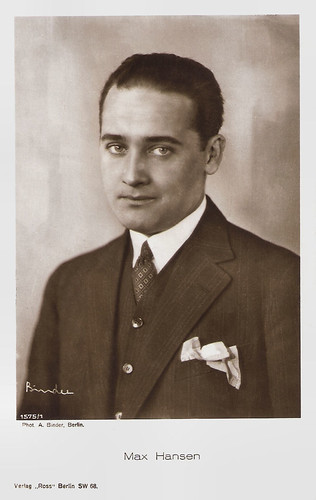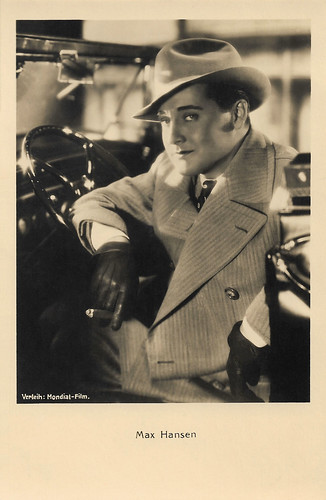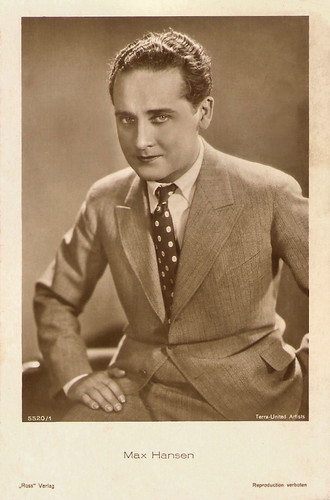One of the highlights of the programme is Das Kabinett des Dr. Larifari (1930) by Robert Wohlmuth, a parody of the silent expressionist classic, Das Cabinet des Dr. Caligari/The Cabinet of Dr. Caligari (Robert Wiene, 1920). The comedy was written by Max Hansen and Paul Morgan and they were also the stars. Tomorrow EFSP will focus on Morgan, but today's post presents the Danish cabaret artist, actor, comedian and singer Max Hansen (1897-1961), who was known as 'The Little Caruso'. During the 1920s, he was one of the most popular stars in Berlin.

German postcard by Ross Verlag, no. 1575/1, 1927-1928. Photo: Alex Binder, Berlin.

German postcard by Ross Verlag, no. 1863/1, 1927-1928. Photo: Atelier Schneider, Berlin.

German postcard by Ross Verlag, no. 3156/1, 1928-1929. Photo: Alex Binder, Berlin.

German postcard by Ross Verlag, no. 5555/1, 1930-1931. Photo: Freiherr von Gudenberg, Berlin.

Austrian postcard by Iris Verlag, no. 6307. Photo: Mondial Film.

German postcard by Ross Verlag, no. 154/1. Photo: FFG (Carl Froelich Film Produktion). Ferdinand von Alten, Gitta Alpar and Max Hansen in Die - oder keine/She - or Nobody (Carl Froelich, 1932).
Who takes love seriously?
Max Hansen was born Max Josef Haller in Mannheim, Imperial Germany in 1897. He was an illegitimate child to the Danish actress Eva Haller and the Swedish Officer Schürer von Waldheim (according to other sources he had a Jewish father, the Hungarian artist Joseph Walder). Max grew up with foster parents in Munich, where he first appeared at the Cabaret Simplizissimus at the age of 17.
In 1914 he moved to Vienna, where he completed his studies as a ballad singer. Filmportal.de: “Thinking that it may perhaps be advantageous to draw attention to his Scandinavian origins, he changes his name to Hansen. Profiting from his powerful, highly modulating voice, he becomes known as the ‘little Caruso’ in cabarets and variety theatres, performing comical couplets, sketches and opera parodies.” In 1923, Hansen was discovered by Hubert Marischka. He asked him for the tenor role of Baron Kolomán Zsupán in the Emmerich Kálmán operetta 'Gräfin Mariza' (Countess Mariza) at the Theater an der Wien in Vienna. After 900 performances, the popular production moved to the Metropol Theater in Berlin, where Hansen became also very successful.
In Berlin, he founded the KadeKo, the Kabarett der Komiker (the Cabaret of Comedians) with Paul Morgan and Kurt Robitschek in 1924. Hansen was engaged by Max Reinhardt for his revival of Jacques Offenbach's 'La belle Hélène', and by Erik Charell for his production of Franz Lehar's 'Die lustige Witwe' (The Merry Widow). Hansen's greatest stage success was playing Leopold the waiter in Ralph Benatzky's operetta-musical 'Im weißen Rößl' (The White Horse Inn) in 1930.
He had already undertaken this part in the silent film Im weißen Rößl/The White Horse Inn (Richard Oswald, 1926) with Liane Haid. A year earlier, he had made his film debut in Husarenfieber/Hussars Fever (Georg Jacoby, 1925) with Georg Alexander. In the following years, he appeared in popular silent films like Familie Schimeck/The Schimeck Family (Alfred Halm, Rudolf Dworsky, 1926), and Venus im Frack/Venus in Evening Dress (Robert Land, 1927) with Carmen Boni. From 1925 on, Hansen also recorded his own hits, which audiences appreciated for their parody and cabaret-like wit.
His real film career began in the sound film era. His first sound film was Wien, du Stadt der Lieder/Vienna, City of Song (Richard Oswald, 1930) with Charlotte Ander and Paul Morgan. The excellent singer was soon pinned down for swinging musicals and comedies. He found an ideal partner in Jenny Jugo in films like Wer nimmt die Liebe ernst.../Who Takes Love Seriously? (Erich Engel, 1931). He also played opposite Gitta Alpár in Die - oder keine/She, or Nobody (Carl Froelich, 1932).

German postcard by Verlag Piek, Postdam, no. 855. Photo: Frhr. von Gudenberg. Max Hansen, Alfred Jerger and Siegfried Arno in the play 'Die drei Musketiere' (The Three Musketeers) (1929) at the Grosse Schauspielhaus.

German postcard by Ross Verlag, no. 121/1. Photo: Richard Oswald Tonfilm / Atlas Verleih. Charlotte Ander and Max Hansen in Wien, Du Stadt der Lieder/Vienna, City of Song (Richard Oswald, 1930).

German postcard by Ross Verlag, no. 5060/1, 1930-1931. Photo: Harlip, Berlin.

German postcard by Ross Verlag, no. 5520/1, 1930-1931. Photo: Terra / United Artists.

Austrian postcard by Iris Verlag, no. 654. Photo: Willinger, Vienna.

Austrian postcard by Iris Verlag, no. 718. Photo: Sascha Film / Aafa.
Have you ever been in love with me?
Max Hansen satirized Adolf Hitler as a homosexual with his song 'War'n Sie schon mal in mich verliebt?' (Have you ever been in love with me?), which caused the rage of the Nazis. He was thrown with tomatoes at the premiere of the comedy Das häßliche Mädchen/The Ugly Girl (Hermann Kosterlitz, 1933). The film was made in early 1933, during the transition from the Weimar Republic to Nazi Germany, and premièred in September that year. According to Wikipedia, the film's representation of the ‘ugly girl’ as an outsider has been described as a metaphorical way to explore the outsider existence of Jews. Star Dolly Haas and director Hermann Kosterlitz, both Jewish, left Germany and later worked in the United States, where Kosterlitz became well-known as Henry Koster.
Hansen returned to Vienna and worked again at the Theater an der Wien. He starred in the film Csardas (Jacob Fleck, Luise Fleck, Walter Kolm-Veltée, 1935) with Irén Zilahy. He also performed in Switzerland, Amsterdam, Oslo and Helsinki. In 1936 he met Zarah Leander on a Scandinavian tour and engaged her as his stage partner in the operetta 'Axel an der Himmels Tür' (Axel at Heaven’s Gate), with music by Ralph Benatzky, produced in Theater an der Wien. It was a hit.
After Austria was invaded by Germany in 1938, Hansen emigrated to Denmark, where he founded his own theatre at Copenhagen. He also appeared in Danish films like Tror du jeg er født i går!/Do You Think I Was Born Yesterday! (Lau Lauritzen, Jr., Alice O'Fredericks, 1941) and En flicka för mej/A Girl for Me (Börje Larsson, 1943). In addition, he wrote several songs under the pseudonym ‘Sylvester’.
In 1951 he returned to Germany and was successful once again singing the role of Leopold the waiter in 'The White Horse Inn'. In 1953 Hansen moved back to Copenhagen, where he died in 1961. His final film appearance was in the Danish comedy Hvad vil De ha'?/What do you want? (Jens Henriksen, Preben Neergaard, 1956) starring Dirch Passer.
Hansen was married to Austrian actress Lizzi Waldmüller till 1938 and since 1940 to Britta Annette Sylvester-Hvid. He had four children. His daughter Ann-Mari Max Hansen (1949) and his son Max Hansen Jr. (1954) were both actors too. In 2004 German director Douglas Wolfsperger portrayed Hansen in his documentary War'n Sie schon mal in mich verliebt?

German postcard by Ross Verlag / Odeon. Photo: Schneider, Berlin.

German postcard by Ross Verlag, no. 5542/1, 1930-1931. Photo: Biograph-Film.

German postcard by Ross Verlag, no. 5862/1, 1930-1931. Photo: Becker & Maass, Berlin.

Austrian postcard by Iris Verlag, no. 6608. Photo: Froelich Film / Lux Film Verleih. Max Hansen and Gitta Alpar in Die - oder keine/She - or Nobody (Carl Froelich, 1932).

German postcard by Ross Verlag, no. 7159/1, 1932-1933. Photo: FFG. Max Hansen and Gitta Alpar in Die - oder keine/This One or None (Carl Froelich, 1932).

German postcard by Ross Verlag, no. 7160/1, 1932-1933. Photo: FFG. Max Hansen in Die - oder keine/She, or Nobody (Carl Froelich, 1932).
Max Hansen sings War'n Sie schon mal in mich verliebt?. Source: Edmolch (YouTube).
Sources: Thomas Staedeli (Cyranos), Stephanie D’heil (Steffi-line), Rudi Polt (IMDb), Filmportal.de, Wikipedia, and IMDb.
This post was last updated on 3 August 2024.
No comments:
Post a Comment